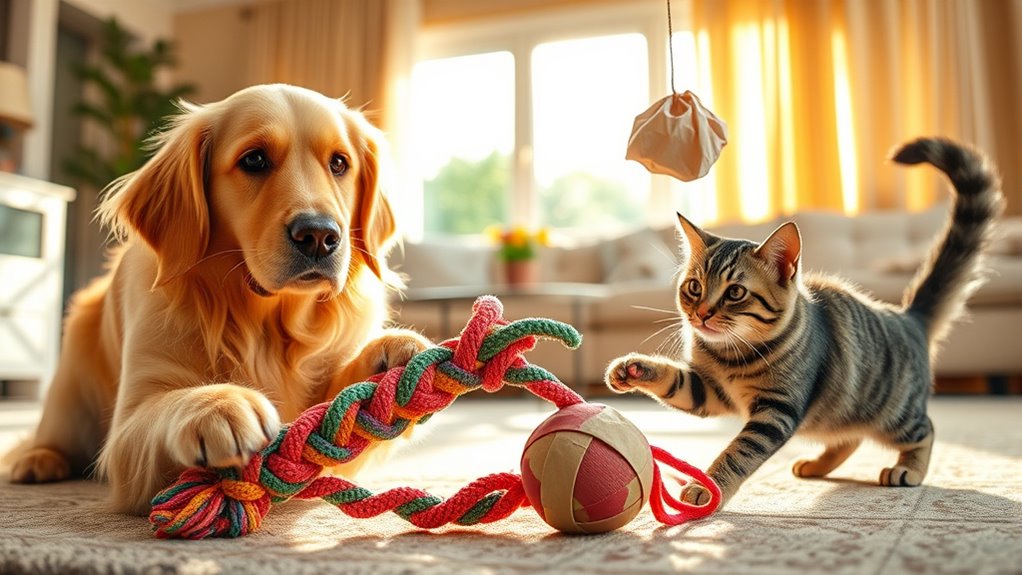You can easily keep your dog or cat entertained on a budget by making DIY toys from household recycled items. Use cardboard boxes, plastic bottles, old T-shirts, or muffin tins to create engaging puzzles and chew toys. These homemade options are cost-effective, eco-friendly, and customizable to fit your pet’s preferences. Regularly inspect and craft new toys to prevent boredom. If you want more ideas on safe and fun DIY pet toys, keep exploring beyond this!
Key Takeaways
- Use household recycled items like cardboard and plastic bottles to create safe, engaging toys for dogs and cats.
- Make simple puzzles by hiding treats inside layered cardboard or plastic containers to stimulate your pet’s problem-solving skills.
- Craft tug toys or braided playthings from old T-shirts or socks for budget-friendly, durable entertainment.
- Regularly inspect DIY toys for wear and safety to prevent choking or injuries during playtime.
- Recycling household waste into pet toys reduces expenses and promotes eco-consciousness while keeping pets mentally stimulated.

Have you ever thought about how easy and fun it can be to create your own pet toys at home? Making DIY toys not only saves you money but also gives you the chance to customize playthings that perfectly suit your pet’s preferences. One of the most engaging projects is crafting a homemade puzzle for your dog or cat. It’s a fantastic way to challenge their minds and keep them entertained for hours. You don’t need fancy equipment—just some recycled materials you likely already have around the house.
To start, gather some common recycled materials like cardboard boxes, plastic bottles, or muffin tins. Cardboard, in particular, is perfect for creating a homemade puzzle. You can cut it into various shapes, then hide treats inside or underneath different layers. Your pet will enjoy figuring out how to access the hidden goodies, stimulating their natural problem-solving instincts. For added complexity, you can make a layered puzzle by stacking pieces of cardboard with treats tucked between, or by creating a puzzle board with different compartments that your pet has to open or slide to find the reward.
Using recycled materials not only reduces waste but also allows you to be inventive. For example, take an empty plastic bottle, remove the cap, and fill it with dry kibble or treats. Seal the opening with tape or a sturdy fabric and let your pet roll it around. The movement and noise will intrigue them, encouraging play and activity. You can even make a simple puzzle by cutting holes into a plastic container and hiding treats inside. Your pet will need to figure out how to access the treats, providing mental stimulation and preventing boredom.
Another clever idea is transforming old T-shirts or socks into tug toys or braided chew toys. These are easy to make and safe for your pets to chew on. Plus, by choosing recycled textiles, you avoid purchasing new toys and give old clothes a second life. The key is to think creatively about what materials you have available. Often, household items can be turned into fun, engaging toys without any extra cost.
Additionally, understanding safety considerations when creating and using homemade toys ensures your pet remains safe during playtime. Creating DIY pet toys from recycled materials is not only budget-friendly but also a rewarding activity that strengthens your bond with your furry friend. It’s about turning everyday items into stimulating, safe, and personalized playthings. Your pet will love the extra attention and effort you put into their toys, and you’ll enjoy knowing you’re being eco-conscious. So next time you’re about to toss something out, consider whether it could become a new favorite toy for your pet. With a little imagination, you can keep your dog or cat entertained and happy without breaking the bank.
Frequently Asked Questions
Are Homemade Toys Safe for All Dog and Cat Breeds?
You wonder if homemade toys are safe for all dog and cat breeds. It’s important to take into account material safety and breed suitability. Some materials, like certain plastics or small parts, can be harmful, especially for chewers or old pets. You should choose non-toxic, durable materials and avoid small pieces that could be swallowed. Tailor toys to your pet’s breed and size to ensure safety and enjoyment for every furry friend.
How Often Should I Replace DIY Pet Toys?
You should replace your DIY pet toys based on toy longevity and replacement frequency. Regularly inspect for wear and tear, fraying, or damage that might pose safety risks. Generally, plan to replace toys every few weeks to a couple of months, depending on how often your pet plays with them. Prioritize safety by removing any broken or worn-out toys, ensuring your pet stays entertained without risking injury.
Can DIY Toys Help With My Pet’S Behavioral Issues?
DIY toys can definitely help with your pet’s behavioral issues by promoting interactive play and mental stimulation. When you create engaging toys at home, your pet stays mentally active, reducing boredom that often leads to destructive behaviors. Plus, interactive play strengthens your bond. Just guarantee the toys are safe and appropriate for your pet’s size and preferences, and you’ll see positive changes in their behavior over time.
What Materials Are Best for Making Durable Pet Toys?
When choosing materials for durable pet toys, prioritize non-toxic fabrics to keep your pet safe and healthy. Reinforced rubber is another excellent option, providing strength and longevity even with active chewers. You should avoid cheap plastics or flimsy materials that can break easily and pose choking hazards. By selecting sturdy, pet-safe materials like non-toxic fabrics and reinforced rubber, you create toys that last longer and withstand your pet’s playtime.
Are There Age-Specific DIY Toys for Puppies or Senior Pets?
You can make age-specific DIY toys by focusing on your pet’s needs. For puppies, create puppy teething toys with soft, durable materials like rubber or braided fabric to soothe gums. For senior pets, focus on senior pet enrichment by designing gentle puzzle toys or soft plush toys that are easy to handle. Tailoring toys to their age guarantees your dog stays entertained and comfortable, promoting healthy development and well-being.
Conclusion
Now that you’ve got these simple DIY toys, your furry friend will stay entertained without breaking the bank. Just like a true artisan of old, you’re crafting happiness with your own hands—no need for fancy store-bought stuff. Keep experimenting, and soon you’ll have a treasure trove of fun toys that keep tails wagging and purrs rolling. Remember, the best toys are made with love and a dash of creativity—because a happy pet makes a happy home.








